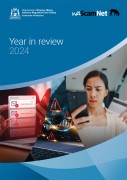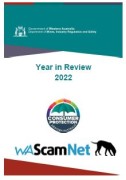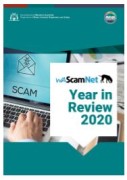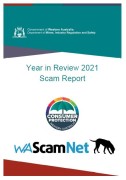Each year the Department of Local Government, Industry Regulation and Safety (LGIRS) – Consumer Protection Division (Consumer Protection), which operates WA ScamNet, receives a large number of enquiries concerning scam related problems.
Many of these enquiries are lower-level concerns where consumers wish to advise Consumer Protection of an email, phone call or some form of interaction they have had with a potential scam. These types of enquiries are dealt with by Consumer Protection’s Contact Centre.
Other more detailed enquiries are managed by Consumer Protection’s WA ScamNet team; these enquiries tend to be more detailed in nature often including situations where consumers have fallen victim to a scam.
The reports below detail a review of the enquiries Consumer Protection recieves over the calendar year.
2024 report - Celebrity fake and crypto cons fuel record year for scams
Scam losses surgued in 2024, with 940 Western Australian reported losing a total of $29.1 million - up 28 per cent from 2023.
Driving the record losses in were numerous large-scale investment scams, including an astonishing loss of more than $10 million from a single victim lured by a fake online celebrity endorsement video.
Buy/sell scams on online marketplaces led to the highest victim count in 2024, accounting for 35 per cent of all victims with 332 people affected. Online shopping scams followed with 161 victims and phishing scams with 78.
Read the full 2024 WA Scam Review report.
2023 report - Record year for WA cybercime as Facebook scams surge
Scam records were shattered in 2023 with 1,398 Western Australian victims reportedly fleeced of $21,995,489, up 36 per cent from 2022.
Data showing buyers and sellers on classified sites and online marketplaces accounted for the highest number of victims across all scam-types.
Of the 435 people who reported losing $590,000 on buy/sell classified sites, Facebook Marketplace was responsible for 163 victims and $116,500 in losses.
Another common Marketplace scam involved fake rental property listings, where scammers posed as landlords to fleece prospective tenants of upfront bond and rent money.
Read the full 2023 WA Scam Review report and the Department's media statement.
2022 report - Online shopping and trading scams hit record WA victims in 2022
Scam losses and the number of reports and victims in Western Australia broke records in 2022, with 1,203 people losing a combined $15,988,513 - a seven per cent increase on 2021’s record losses.
The report reveals online shopping and buying/selling classified scams claimed the most victims over the past year, while investment and romance scams recorded the highest financial losses.
A total of 274 online shoppers lost $876,774 and 270 buyers and sellers on classified sites lost $564,680.
Investment scams, mainly involving crypto currencies, were to blame for $6,980,254 in losses, while $2,871,468 was lost to dating/romance scams, with one individual loss of $800,000 reported in May 2022.
One of the most disturbing scams of the year involved people receiving texts from criminals masquerading as their children needing urgent funds. The ‘Hi Mum/Dad’ scam tricked 59 WA victims into paying a total of $265,353.
Read the full 2022 WA Scam Review report and the Department's media statement.
2021 report - Record number of WA scam victims and losses in 2021
A record number of Western Australians fell victim to scams in 2021, also losing a record amount of money.
In its 2021 Year in Review Scam Report, WA ScamNet at Consumer Protection reveals 1,041 victims, an increase of 10 per cent from the previous year, reported losses totalling $14,791,708, an increase of 27 per cent. There were 4,128 scam reports received in total, an increase of 18 per cent.
These are the highest figures recorded since the annual scam reports were first compiled in 2015.
The greatest financial losses were recorded as result of investment cons ($6.67 million), mainly cryptocurrency, and romance/dating scams ($2.99 million).
Read the full 2021 WA Scam Review report and the Department's media statement.
2020 report - Five-fold increase in online shopping scam losses in WA in 2020
An increase in online shopping activity during the COVID-19 pandemic has resulted in a huge 500 per cent increase in losses to scams for that category in 2020 statistics compiled by WA ScamNet at Consumer Protection. 
In 2020, 257 online shoppers in WA reported total losses of $653,745, compared to 129 victims losing $127,304 in 2019.
There was also a doubling of losses and the number of scam victims in the ‘classifieds’ category with 241 consumers who were looking for second-hand goods losing a total of $544,172, compared to 126 victims losing $191,792 in 2019.
Overall, there were more scam victims but less money lost in 2020 with 952 victims losing $11.8 million. In 2019, there were 705 victims reporting $13.6 million in losses. As in most years, investment ($5.38 million) and romance ($2.17 million) scams topped the list of categories.
Read the full 2020 WA Scam Review report and the Department's media statement.




